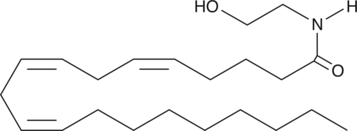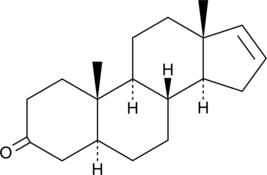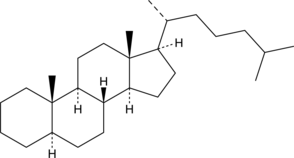Chemicals
Showing 6751–6900 of 41137 results
-
5(S)-HETE-d8 contains eight deuterium atoms at the 5, 6, 8, 9, 11, 12, 14, and 15 positions. It is intended for use as an internal standard for the quantification of 5(S)-HETE by GC- or LC-mass spectrometry (MS). 5(S)-HETE is produced by the action of 5-lipoxygenase on arachidonic acid to give 5(S)-HpETE, followed by reduction of the hydroperoxide. 5(S)-HETE has proliferative and chemotactic effects on granulocytes.{1329} When further metabolized to the 5-oxoETE, it is a more potent eosinophil chemoattractant than leukotriene B4.{2090,556}
Brand:CaymanSKU:334230 - 50 µgAvailable on backorder
-
5(S)-HETrE is produced by the action of 5-LO when mead acid is the substrate.{6579,689} There are no literature reports of the biological activity or further metabolic fate of 5(S)-HETrE.
Brand:CaymanSKU:36230 - 100 µgAvailable on backorder
-
5(S)-HETrE is produced by the action of 5-LO when mead acid is the substrate.{6579,689} There are no literature reports of the biological activity or further metabolic fate of 5(S)-HETrE.
Brand:CaymanSKU:36230 - 25 µgAvailable on backorder
-
5(S)-HETrE is produced by the action of 5-LO when mead acid is the substrate.{6579,689} There are no literature reports of the biological activity or further metabolic fate of 5(S)-HETrE.
Brand:CaymanSKU:36230 - 250 µgAvailable on backorder
-
5(S)-HETrE is produced by the action of 5-LO when mead acid is the substrate.{6579,689} There are no literature reports of the biological activity or further metabolic fate of 5(S)-HETrE.
Brand:CaymanSKU:36230 - 50 µgAvailable on backorder
-
5(S)-HpEPE is a monohydroperoxy polyunsaturated fatty acid produced by the action of 5-LO on EPA.{1144} It is metabolized to LTA5, a key intermediate in the formation of the 5-series leukotrienes. Alternatively, 5(S)-HpEPE is reduced to 5(S)-HEPE by peroxidases.
Brand:CaymanSKU:42210 - 100 µgAvailable on backorder
-
5(S)-HpEPE is a monohydroperoxy polyunsaturated fatty acid produced by the action of 5-LO on EPA.{1144} It is metabolized to LTA5, a key intermediate in the formation of the 5-series leukotrienes. Alternatively, 5(S)-HpEPE is reduced to 5(S)-HEPE by peroxidases.
Brand:CaymanSKU:42210 - 25 µgAvailable on backorder
-
5(S)-HpEPE is a monohydroperoxy polyunsaturated fatty acid produced by the action of 5-LO on EPA.{1144} It is metabolized to LTA5, a key intermediate in the formation of the 5-series leukotrienes. Alternatively, 5(S)-HpEPE is reduced to 5(S)-HEPE by peroxidases.
Brand:CaymanSKU:42210 - 50 µgAvailable on backorder
-
5(S)-HpETE is a monohydroperoxy polyunsaturated fatty acid (PUFA) produced by the action of 5-LO on arachidonic acid. It is metabolized to leukotriene A4 (LTA4), a key intermediate in the formation of LTs.{595} 5(S)-HpETE (1 µM) mediates the induction of the proto-oncogene c-fos in TNF-stimulated TA1 cells.{167}
Brand:CaymanSKU:44230 - 100 µgAvailable on backorder
-
5(S)-HpETE is a monohydroperoxy polyunsaturated fatty acid (PUFA) produced by the action of 5-LO on arachidonic acid. It is metabolized to leukotriene A4 (LTA4), a key intermediate in the formation of LTs.{595} 5(S)-HpETE (1 µM) mediates the induction of the proto-oncogene c-fos in TNF-stimulated TA1 cells.{167}
Brand:CaymanSKU:44230 - 25 µgAvailable on backorder
-
5(S)-HpETE is a monohydroperoxy polyunsaturated fatty acid (PUFA) produced by the action of 5-LO on arachidonic acid. It is metabolized to leukotriene A4 (LTA4), a key intermediate in the formation of LTs.{595} 5(S)-HpETE (1 µM) mediates the induction of the proto-oncogene c-fos in TNF-stimulated TA1 cells.{167}
Brand:CaymanSKU:44230 - 250 µgAvailable on backorder
-
5(S)-HpETE is a monohydroperoxy polyunsaturated fatty acid (PUFA) produced by the action of 5-LO on arachidonic acid. It is metabolized to leukotriene A4 (LTA4), a key intermediate in the formation of LTs.{595} 5(S)-HpETE (1 µM) mediates the induction of the proto-oncogene c-fos in TNF-stimulated TA1 cells.{167}
Brand:CaymanSKU:44230 - 50 µgAvailable on backorder
-
5(S),12(S)-DiHETE is a natural bioactive lipid derived from arachidonic acid (AA; Item No. 10006607). It is synthesized by glycogen-induced rabbit peritoneal polymorphonuclear leukocytes (PMNLs) incubated with AA.{530} 5(S),12(S)-DiHETE can be produced by successive oxygenation of AA by 5-lipoxygenase (5-LO) in platelets and 12-LO in leukocytes.{577} It can also be synthesized from 12(S)-HETE by 5-LO, in the presence of 5-LO activating protein (FLAP), activated with calcium ionophore.{7243} 5(S),12(S)-DiHETE is an epimer of leukotriene B4 (Item No. 20110) that is weakly chemotactic for PMNL.{551}
Brand:CaymanSKU:35260 - 100 µgAvailable on backorder
-
5(S),12(S)-DiHETE is a natural bioactive lipid derived from arachidonic acid (AA; Item No. 10006607). It is synthesized by glycogen-induced rabbit peritoneal polymorphonuclear leukocytes (PMNLs) incubated with AA.{530} 5(S),12(S)-DiHETE can be produced by successive oxygenation of AA by 5-lipoxygenase (5-LO) in platelets and 12-LO in leukocytes.{577} It can also be synthesized from 12(S)-HETE by 5-LO, in the presence of 5-LO activating protein (FLAP), activated with calcium ionophore.{7243} 5(S),12(S)-DiHETE is an epimer of leukotriene B4 (Item No. 20110) that is weakly chemotactic for PMNL.{551}
Brand:CaymanSKU:35260 - 25 µgAvailable on backorder
-
5(S),12(S)-DiHETE is a natural bioactive lipid derived from arachidonic acid (AA; Item No. 10006607). It is synthesized by glycogen-induced rabbit peritoneal polymorphonuclear leukocytes (PMNLs) incubated with AA.{530} 5(S),12(S)-DiHETE can be produced by successive oxygenation of AA by 5-lipoxygenase (5-LO) in platelets and 12-LO in leukocytes.{577} It can also be synthesized from 12(S)-HETE by 5-LO, in the presence of 5-LO activating protein (FLAP), activated with calcium ionophore.{7243} 5(S),12(S)-DiHETE is an epimer of leukotriene B4 (Item No. 20110) that is weakly chemotactic for PMNL.{551}
Brand:CaymanSKU:35260 - 50 µgAvailable on backorder
-
5(S),15(S)-DiHETE is synthesized by 15-LO from 5(S)-HETE.{306} It potentiates the degranulation of human PMNL in response to PAF, but not fMLP, calcium ionophore A23187, or LTB4.{578} 5(S),15(S)-DiHETE is chemotactic for eosinophils with an ED50 value of 0.3 µM.{2161}
Brand:CaymanSKU:35280 - 100 µgAvailable on backorder
-
5(S),15(S)-DiHETE is synthesized by 15-LO from 5(S)-HETE.{306} It potentiates the degranulation of human PMNL in response to PAF, but not fMLP, calcium ionophore A23187, or LTB4.{578} 5(S),15(S)-DiHETE is chemotactic for eosinophils with an ED50 value of 0.3 µM.{2161}
Brand:CaymanSKU:35280 - 25 µgAvailable on backorder
-
5(S),15(S)-DiHETE is synthesized by 15-LO from 5(S)-HETE.{306} It potentiates the degranulation of human PMNL in response to PAF, but not fMLP, calcium ionophore A23187, or LTB4.{578} 5(S),15(S)-DiHETE is chemotactic for eosinophils with an ED50 value of 0.3 µM.{2161}
Brand:CaymanSKU:35280 - 50 µgAvailable on backorder
-
5(S),6(R)-11-trans DiHETE is a C-11 double bond isomer of 5(S),6(R)-DiHETE that is formed by the enzymatic isomerization of 5(S),6(R)-DiHETE by a membrane bound factor.{14924} 5(S),6(R)-11-trans DiHETE has been found in rat kidney homogenates and is potentially formed by the epoxide hydrolase pathway in this tissue.{14924} The isomerase activity responsible for the conversion of leukotriene B4 (LTB4) to 6-trans LTB4 in rat kidney homogenates has also been implicated in its formation.{14925} 5(S),6(R)-11-trans DiHETE is not a substrate for soybean lipoxygenase.{14924} The biological activity of 5(S),6(R)-11-trans DiHETE has not been reported.
Brand:CaymanSKU:10009628 - 100 µgAvailable on backorder
-
5(S),6(R)-11-trans DiHETE is a C-11 double bond isomer of 5(S),6(R)-DiHETE that is formed by the enzymatic isomerization of 5(S),6(R)-DiHETE by a membrane bound factor.{14924} 5(S),6(R)-11-trans DiHETE has been found in rat kidney homogenates and is potentially formed by the epoxide hydrolase pathway in this tissue.{14924} The isomerase activity responsible for the conversion of leukotriene B4 (LTB4) to 6-trans LTB4 in rat kidney homogenates has also been implicated in its formation.{14925} 5(S),6(R)-11-trans DiHETE is not a substrate for soybean lipoxygenase.{14924} The biological activity of 5(S),6(R)-11-trans DiHETE has not been reported.
Brand:CaymanSKU:10009628 - 25 µgAvailable on backorder
-
5(S),6(R)-11-trans DiHETE is a C-11 double bond isomer of 5(S),6(R)-DiHETE that is formed by the enzymatic isomerization of 5(S),6(R)-DiHETE by a membrane bound factor.{14924} 5(S),6(R)-11-trans DiHETE has been found in rat kidney homogenates and is potentially formed by the epoxide hydrolase pathway in this tissue.{14924} The isomerase activity responsible for the conversion of leukotriene B4 (LTB4) to 6-trans LTB4 in rat kidney homogenates has also been implicated in its formation.{14925} 5(S),6(R)-11-trans DiHETE is not a substrate for soybean lipoxygenase.{14924} The biological activity of 5(S),6(R)-11-trans DiHETE has not been reported.
Brand:CaymanSKU:10009628 - 50 µgAvailable on backorder
-
Lipoxins are trihydroxytetraene metabolites derived from arachidonic acid through an interaction between lipoxygenases with C-5 and C-15 specificities. Lipoxin A4 (LXA4) inhibits the chemotactic responsiveness of polymorphonuclear (PMN) neutrophils to leukotriene B4 and to the peptide formyl-methionyl-leucyl-phenylalanine (fMLP).{14813} 5(S),6(R)-7-trihydroxymethyl Heptanoate is a C-7 truncated analog of lipoxin A4 (LXA4) that is equiactive as LXA4 in the inhibition of leukotriene B4 (LTB4)-induced polymorphonuclear neutrophils (PMN) chemotaxis with an IC50 value of 5nM.{14813}
Brand:CaymanSKU:10005032 - 1 mgAvailable on backorder
-
Lipoxins are trihydroxytetraene metabolites derived from arachidonic acid through an interaction between lipoxygenases with C-5 and C-15 specificities. Lipoxin A4 (LXA4) inhibits the chemotactic responsiveness of polymorphonuclear (PMN) neutrophils to leukotriene B4 and to the peptide formyl-methionyl-leucyl-phenylalanine (fMLP).{14813} 5(S),6(R)-7-trihydroxymethyl Heptanoate is a C-7 truncated analog of lipoxin A4 (LXA4) that is equiactive as LXA4 in the inhibition of leukotriene B4 (LTB4)-induced polymorphonuclear neutrophils (PMN) chemotaxis with an IC50 value of 5nM.{14813}
Brand:CaymanSKU:10005032 - 10 mgAvailable on backorder
-
Lipoxins are trihydroxytetraene metabolites derived from arachidonic acid through an interaction between lipoxygenases with C-5 and C-15 specificities. Lipoxin A4 (LXA4) inhibits the chemotactic responsiveness of polymorphonuclear (PMN) neutrophils to leukotriene B4 and to the peptide formyl-methionyl-leucyl-phenylalanine (fMLP).{14813} 5(S),6(R)-7-trihydroxymethyl Heptanoate is a C-7 truncated analog of lipoxin A4 (LXA4) that is equiactive as LXA4 in the inhibition of leukotriene B4 (LTB4)-induced polymorphonuclear neutrophils (PMN) chemotaxis with an IC50 value of 5nM.{14813}
Brand:CaymanSKU:10005032 - 5 mgAvailable on backorder
-
5(S),6(R)-DiHETE is a dihydroxy polyunsaturated fatty acid and a nonenzymatic hydrolysis product of leukotriene A4 (LTA4). Mouse liver cytosolic epoxide hydrolase catalyzes the conversion of LTA4 to 5(S),6(R)-DiHETE.{575} It is a weak LTD4 receptor agonist in guinea pig lung membranes.{296} It induces guinea pig ileum contraction with an ED50 value of 1.3 µM.{296}
Brand:CaymanSKU:35200 - 100 µgAvailable on backorder
-
5(S),6(R)-DiHETE is a dihydroxy polyunsaturated fatty acid and a nonenzymatic hydrolysis product of leukotriene A4 (LTA4). Mouse liver cytosolic epoxide hydrolase catalyzes the conversion of LTA4 to 5(S),6(R)-DiHETE.{575} It is a weak LTD4 receptor agonist in guinea pig lung membranes.{296} It induces guinea pig ileum contraction with an ED50 value of 1.3 µM.{296}
Brand:CaymanSKU:35200 - 25 µgAvailable on backorder
-
5(S),6(R)-DiHETE is a dihydroxy polyunsaturated fatty acid and a nonenzymatic hydrolysis product of leukotriene A4 (LTA4). Mouse liver cytosolic epoxide hydrolase catalyzes the conversion of LTA4 to 5(S),6(R)-DiHETE.{575} It is a weak LTD4 receptor agonist in guinea pig lung membranes.{296} It induces guinea pig ileum contraction with an ED50 value of 1.3 µM.{296}
Brand:CaymanSKU:35200 - 50 µgAvailable on backorder
-
5(S),6(R)-DiHETE is a dihydroxy polyunsaturated fatty acid and a nonenzymatic hydrolysis product of leukotriene A4 (LTA4). Mouse liver cytosolic epoxide hydrolase catalyzes the conversion of LTA4 to 5(S),6(R)-DiHETE.{575} 5(S),6(R)-DiHETE is a weak LTD4 (Item No. 20310) receptor agonist in guinea pig lung membranes.{296} It induces guinea pig ileum contraction with an ED50 value of 1.3 µM.{296} 5(S),6(R)-DiHETE MaxSpec® standard is a quantitative grade standard of 5(S),6(R)-DiHETE (Item No. 35200) that has been prepared specifically for mass spectrometry or any application where quantitative reproducibility is required. The solution has been prepared gravimetrically and is supplied in a deactivated glass ampule sealed under argon. The concentration was verified by comparison to an independently prepared calibration standard. This 5(S),6(R)-DiHETE MaxSpec® standard is guaranteed to meet identity, purity, stability, and concentration specifications and is provided with a batch-specific certificate of analysis. Ongoing stability testing is performed to ensure the concentration remains accurate throughout the shelf life of the product. Note: The amount of solution added to the vial is in excess of the listed amount. Therefore, it is necessary to accurately measure volumes for preparation of calibration standards. Follow recommended storage and handling conditions to maintain product quality.
Brand:CaymanSKU:10007252 - 100 µgAvailable on backorder
-
5(S),6(S)-DiHETE is one of the four diastereomeric 5,6-dihydroxy acids produced from the non-enzymatic hydrolysis of LTA4.{530} 5(S),6(S)-DiHETE does not have significant leukotriene-like activity.{296}
Brand:CaymanSKU:35210 - 100 µgAvailable on backorder
-
5(S),6(S)-DiHETE is one of the four diastereomeric 5,6-dihydroxy acids produced from the non-enzymatic hydrolysis of LTA4.{530} 5(S),6(S)-DiHETE does not have significant leukotriene-like activity.{296}
Brand:CaymanSKU:35210 - 25 µgAvailable on backorder
-
5(S),6(S)-DiHETE is one of the four diastereomeric 5,6-dihydroxy acids produced from the non-enzymatic hydrolysis of LTA4.{530} 5(S),6(S)-DiHETE does not have significant leukotriene-like activity.{296}
Brand:CaymanSKU:35210 - 50 µgAvailable on backorder
-
5(S),6(S)-DiHETE is one of the four diastereomeric 5,6-dihydroxy acids produced from the non-enzymatic hydrolysis of LTA4.{530} 5(S),6(S)-DiHETE does not have significant leukotriene-like activity.{296} 5(S),6(S)-DiHETE MaxSpec® standard is a quantitative grade standard of 5(S),6(S)-DiHETE (Item No. 35210) that has been prepared specifically for mass spectrometry and related applications where quantitative reproducibility is required. The solution has been prepared gravimetrically and is supplied in a deactivated glass ampule sealed under argon. The concentration was verified by comparison to an independently prepared calibration standard. This 5(S),6(S)-DiHETE MaxSpec® standard is guaranteed to meet identity, purity, stability, and concentration specifications and is provided with a batch-specific certificate of analysis. Ongoing stability testing is performed to ensure the concentration remains accurate throughout the shelf life of the product. Note: The amount of solution added to the vial is in excess of the listed amount. Therefore, it is necessary to accurately measure volumes for preparation of calibration standards. Follow recommended storage and handling conditions to maintain product quality.
Brand:CaymanSKU:10007253 - 10 µgAvailable on backorder
-
5(Z),11(Z),14(Z)-Eicosatrienoic acid is a polyunsaturated fatty acid found in various natural sources including maritime pine (Pinus pinaster) seed oil (MPSO), gymnospermae leaves and seeds, and freshwater gastropods.{14273,14945,14947} A diet containing MPSO lowered high-density lipoprotein and ApoA1 levels in transgenic mice expressing human ApoA1. MPSO was found to diminish cholesterol efflux in vitro.{14273} 5(Z),11(Z),14(Z)-Eicosatrienoic acid methyl ester, when topically applied, reduces inflammatory processes, potentially by displacing arachidonic acid from phospholipid pools and reducing downstream inflammatory products such as prostaglandin E2 and leukotrienes.{14946}
Brand:CaymanSKU:10009999 - 1 mgAvailable on backorder
-
5(Z),11(Z),14(Z)-Eicosatrienoic acid is a polyunsaturated fatty acid found in various natural sources including maritime pine (Pinus pinaster) seed oil (MPSO), gymnospermae leaves and seeds, and freshwater gastropods.{14273,14945,14947} A diet containing MPSO lowered high-density lipoprotein and ApoA1 levels in transgenic mice expressing human ApoA1. MPSO was found to diminish cholesterol efflux in vitro.{14273} 5(Z),11(Z),14(Z)-Eicosatrienoic acid methyl ester, when topically applied, reduces inflammatory processes, potentially by displacing arachidonic acid from phospholipid pools and reducing downstream inflammatory products such as prostaglandin E2 and leukotrienes.{14946}
Brand:CaymanSKU:- -
5(Z),11(Z),14(Z)-Eicosatrienoic acid is a polyunsaturated fatty acid found in various natural sources including maritime pine (Pinus pinaster) seed oil (MPSO), gymnospermae leaves and seeds, and freshwater gastropods.{14273,14945,14947} A diet containing MPSO lowered high-density lipoprotein and ApoA1 levels in transgenic mice expressing human ApoA1. MPSO was found to diminish cholesterol efflux in vitro.{14273} 5(Z),11(Z),14(Z)-Eicosatrienoic acid methyl ester, when topically applied, reduces inflammatory processes, potentially by displacing arachidonic acid from phospholipid pools and reducing downstream inflammatory products such as prostaglandin E2 and leukotrienes.{14946}
Brand:CaymanSKU:10009999 - 100 µgAvailable on backorder
-
5(Z),11(Z),14(Z)-Eicosatrienoic acid is a polyunsaturated fatty acid found in various natural sources including maritime pine (Pinus pinaster) seed oil (MPSO), gymnospermae leaves and seeds, and freshwater gastropods.{14273,14945,14947} A diet containing MPSO lowered high-density lipoprotein and ApoA1 levels in transgenic mice expressing human ApoA1. MPSO was found to diminish cholesterol efflux in vitro.{14273} 5(Z),11(Z),14(Z)-Eicosatrienoic acid methyl ester, when topically applied, reduces inflammatory processes, potentially by displacing arachidonic acid from phospholipid pools and reducing downstream inflammatory products such as prostaglandin E2 and leukotrienes.{14946}
Brand:CaymanSKU:10009999 - 500 µgAvailable on backorder
-
5(Z),14(Z)-Eicosadienoic Acid is a novel ω-6 C20:2 fatty acid. The more common 11(Z),14(Z)-eicosadienoic acid competitively inhibits inosine 5’-monophosphate dehydrogenase (Ki = 3.1 µM){16478} and inhibits the binding of LTB4 to its receptor on neutrophils (Ki = 3.0 µM).{2361} Also, serum levels of eicosadienoic acids negatively correlate with degree of sleep disturbance.{16477} Eicosadienoic acids are converted by desaturases, in vivo, to eicosatrienoic acids, which are potent vasodilators. The physiological effects of 5(Z),14(Z)-eicosadienoic acid are unstudied.
Brand:CaymanSKU:10010484 - 1 mgAvailable on backorder
-
5(Z),14(Z)-Eicosadienoic Acid is a novel ω-6 C20:2 fatty acid. The more common 11(Z),14(Z)-eicosadienoic acid competitively inhibits inosine 5’-monophosphate dehydrogenase (Ki = 3.1 µM){16478} and inhibits the binding of LTB4 to its receptor on neutrophils (Ki = 3.0 µM).{2361} Also, serum levels of eicosadienoic acids negatively correlate with degree of sleep disturbance.{16477} Eicosadienoic acids are converted by desaturases, in vivo, to eicosatrienoic acids, which are potent vasodilators. The physiological effects of 5(Z),14(Z)-eicosadienoic acid are unstudied.
Brand:CaymanSKU:10010484 - 100 µgAvailable on backorder
-
5(Z),14(Z)-Eicosadienoic Acid is a novel ω-6 C20:2 fatty acid. The more common 11(Z),14(Z)-eicosadienoic acid competitively inhibits inosine 5’-monophosphate dehydrogenase (Ki = 3.1 µM){16478} and inhibits the binding of LTB4 to its receptor on neutrophils (Ki = 3.0 µM).{2361} Also, serum levels of eicosadienoic acids negatively correlate with degree of sleep disturbance.{16477} Eicosadienoic acids are converted by desaturases, in vivo, to eicosatrienoic acids, which are potent vasodilators. The physiological effects of 5(Z),14(Z)-eicosadienoic acid are unstudied.
Brand:CaymanSKU:10010484 - 500 µgAvailable on backorder
-
Eicosatrienoic acid accumulates in the tissues of animals fed diets deficient in both ω-3 and ω-6 fatty acids. It can be converted to 3-series cysteinyl-leukotrienes but cannot serve as a COX substrate.{4349} The kidneys from essential fatty acid deficient rats are less immunogenic when transplanted, and the metabolites of eicosatrienoic acid are believed to play a role in altering the immune status of these organs.{712}
Brand:CaymanSKU:90190 - 1 mgAvailable on backorder
-
Eicosatrienoic acid accumulates in the tissues of animals fed diets deficient in both ω-3 and ω-6 fatty acids. It can be converted to 3-series cysteinyl-leukotrienes but cannot serve as a COX substrate.{4349} The kidneys from essential fatty acid deficient rats are less immunogenic when transplanted, and the metabolites of eicosatrienoic acid are believed to play a role in altering the immune status of these organs.{712}
Brand:CaymanSKU:90190 - 10 mgAvailable on backorder
-
Eicosatrienoic acid accumulates in the tissues of animals fed diets deficient in both ω-3 and ω-6 fatty acids. It can be converted to 3-series cysteinyl-leukotrienes but cannot serve as a COX substrate.{4349} The kidneys from essential fatty acid deficient rats are less immunogenic when transplanted, and the metabolites of eicosatrienoic acid are believed to play a role in altering the immune status of these organs.{712}
Brand:CaymanSKU:90190 - 5 mgAvailable on backorder
-
5(Z),8(Z),11(Z)-Eicosatrienoic acid ethanolamide is essentially identical to AEA in its agonist binding to CB1 and CB2 receptors. In L cells expressing the human CB1 receptor, the Ki value for 5(Z),8(Z),11(Z)-eicosatrienoic acid ethanolamide and AEA binding is 753 nM. In AtT-20 cells expressing the human CB2 receptor, 5(Z),8(Z),11(Z)-eicosatrienoic acid ethanolamide and AEA bind with a Ki value of 1,810 nM.{5239}
Brand:CaymanSKU:90195 - 1 mgAvailable on backorder
-
5(Z),8(Z),11(Z)-Eicosatrienoic acid ethanolamide is essentially identical to AEA in its agonist binding to CB1 and CB2 receptors. In L cells expressing the human CB1 receptor, the Ki value for 5(Z),8(Z),11(Z)-eicosatrienoic acid ethanolamide and AEA binding is 753 nM. In AtT-20 cells expressing the human CB2 receptor, 5(Z),8(Z),11(Z)-eicosatrienoic acid ethanolamide and AEA bind with a Ki value of 1,810 nM.{5239}
Brand:CaymanSKU:90195 - 10 mgAvailable on backorder
-
5(Z),8(Z),11(Z)-Eicosatrienoic acid ethanolamide is essentially identical to AEA in its agonist binding to CB1 and CB2 receptors. In L cells expressing the human CB1 receptor, the Ki value for 5(Z),8(Z),11(Z)-eicosatrienoic acid ethanolamide and AEA binding is 753 nM. In AtT-20 cells expressing the human CB2 receptor, 5(Z),8(Z),11(Z)-eicosatrienoic acid ethanolamide and AEA bind with a Ki value of 1,810 nM.{5239}
Brand:CaymanSKU:90195 - 5 mgAvailable on backorder
-
5(Z),8(Z),11(Z)-Eicosatrienoic acid ethanolamide is essentially identical to AEA in its agonist binding to CB1 and CB2 receptors. In L cells expressing the human CB1 receptor, the Ki value for 5(Z),8(Z),11(Z)-eicosatrienoic acid ethanolamide and AEA binding is 753 nM. In AtT-20 cells expressing the human CB2 receptor, 5(Z),8(Z),11(Z)-eicosatrienoic acid ethanolamide and AEA bind with a Ki value of 1,810 nM.{5239}
Brand:CaymanSKU:90195 - 500 µgAvailable on backorder
-
Mead acid is a 20-carbon ω-9 polyunsaturated fatty acid. Its level is elevated in plasma during essential fatty acid deficiency in humans.{18702,18703} 5(Z),8(Z),11(Z)-Eicosatrienoic Acid methyl ester (Mead acid methyl ester) is typically used as a standard for the analysis of fatty acids, when the fatty acids have been transesterified to methyl esters before analysis.{18700,18701}
Brand:CaymanSKU:9000215 - 1 mgAvailable on backorder
-
Mead acid is a 20-carbon ω-9 polyunsaturated fatty acid. Its level is elevated in plasma during essential fatty acid deficiency in humans.{18702,18703} 5(Z),8(Z),11(Z)-Eicosatrienoic Acid methyl ester (Mead acid methyl ester) is typically used as a standard for the analysis of fatty acids, when the fatty acids have been transesterified to methyl esters before analysis.{18700,18701}
Brand:CaymanSKU:9000215 - 10 mgAvailable on backorder
-
Mead acid is a 20-carbon ω-9 polyunsaturated fatty acid. Its level is elevated in plasma during essential fatty acid deficiency in humans.{18702,18703} 5(Z),8(Z),11(Z)-Eicosatrienoic Acid methyl ester (Mead acid methyl ester) is typically used as a standard for the analysis of fatty acids, when the fatty acids have been transesterified to methyl esters before analysis.{18700,18701}
Brand:CaymanSKU:9000215 - 5 mgAvailable on backorder
-
Mead acid is a 20-carbon ω-9 polyunsaturated fatty acid. Its level is elevated in plasma during essential fatty acid deficiency in humans.{18702,18703} 5(Z),8(Z),11(Z)-Eicosatrienoic Acid methyl ester (Mead acid methyl ester) is typically used as a standard for the analysis of fatty acids, when the fatty acids have been transesterified to methyl esters before analysis.{18700,18701}
Brand:CaymanSKU:9000215 - 500 µgAvailable on backorder
-
5(Z),8(Z),14(Z)-Eicosatrienoic acid is a polyunsaturated fatty acid that can be a substrate for 5-lipoxygenase (5-LO). 5-LO from RBL-1 cells converts this fatty acid to 5-hydroxy-6,8,14-eicosatrienoic acid and 5-hydroperoxy-6,8,14-eicosatrienoic acid. Due to the lack of a double bond at C-11, this particular fatty acid cannot be used in leukotriene A formation.{14955}
Brand:CaymanSKU:10009733 - 1 mgAvailable on backorder
-
5(Z),8(Z),14(Z)-Eicosatrienoic acid is a polyunsaturated fatty acid that can be a substrate for 5-lipoxygenase (5-LO). 5-LO from RBL-1 cells converts this fatty acid to 5-hydroxy-6,8,14-eicosatrienoic acid and 5-hydroperoxy-6,8,14-eicosatrienoic acid. Due to the lack of a double bond at C-11, this particular fatty acid cannot be used in leukotriene A formation.{14955}
Brand:CaymanSKU:10009733 - 100 µgAvailable on backorder
-
5(Z),8(Z),14(Z)-Eicosatrienoic acid is a polyunsaturated fatty acid that can be a substrate for 5-lipoxygenase (5-LO). 5-LO from RBL-1 cells converts this fatty acid to 5-hydroxy-6,8,14-eicosatrienoic acid and 5-hydroperoxy-6,8,14-eicosatrienoic acid. Due to the lack of a double bond at C-11, this particular fatty acid cannot be used in leukotriene A formation.{14955}
Brand:CaymanSKU:10009733 - 500 µgAvailable on backorder
-
5α-Androst-16-en-3-one is a mammalian pheromone released as a volatile chemical cue in boar saliva to facilitate social and sexual interactions.{29373} It has been used to prime sexual behavior of sows in estrus for mating or artificial insemination. 5α-androst-16-en-3-one is also found in human sweat and urine and has been used to study receptor-mediated odorant detection and the genetic basis for anosmias.{29374}
Brand:CaymanSKU:-Available on backorder
-
5α-Androst-16-en-3-one is a mammalian pheromone released as a volatile chemical cue in boar saliva to facilitate social and sexual interactions.{29373} It has been used to prime sexual behavior of sows in estrus for mating or artificial insemination. 5α-androst-16-en-3-one is also found in human sweat and urine and has been used to study receptor-mediated odorant detection and the genetic basis for anosmias.{29374}
Brand:CaymanSKU:-Available on backorder
-
5α-Androst-16-en-3-one is a mammalian pheromone released as a volatile chemical cue in boar saliva to facilitate social and sexual interactions.{29373} It has been used to prime sexual behavior of sows in estrus for mating or artificial insemination. 5α-androst-16-en-3-one is also found in human sweat and urine and has been used to study receptor-mediated odorant detection and the genetic basis for anosmias.{29374}
Brand:CaymanSKU:-Available on backorder
-
5α-Androst-16-en-3-one is a mammalian pheromone released as a volatile chemical cue in boar saliva to facilitate social and sexual interactions.{29373} It has been used to prime sexual behavior of sows in estrus for mating or artificial insemination. 5α-androst-16-en-3-one is also found in human sweat and urine and has been used to study receptor-mediated odorant detection and the genetic basis for anosmias.{29374}
Brand:CaymanSKU:-Available on backorder
-
5α-Cholestane is a sterol that has been found in dust samples from urban and rural paved and agricultural and public unpaved roads.{47409} It has been used as an internal standard for the quantification of phytosterols by HPLC-MS/MS and fecal sterols by GC-FID and GC-MS.{47410,47411}
Brand:CaymanSKU:26763 - 1 gAvailable on backorder
-
5α-Cholestane is a sterol that has been found in dust samples from urban and rural paved and agricultural and public unpaved roads.{47409} It has been used as an internal standard for the quantification of phytosterols by HPLC-MS/MS and fecal sterols by GC-FID and GC-MS.{47410,47411}
Brand:CaymanSKU:26763 - 250 mgAvailable on backorder
-
5α-Cholestane is a sterol that has been found in dust samples from urban and rural paved and agricultural and public unpaved roads.{47409} It has been used as an internal standard for the quantification of phytosterols by HPLC-MS/MS and fecal sterols by GC-FID and GC-MS.{47410,47411}
Brand:CaymanSKU:26763 - 500 mgAvailable on backorder
-
5α-dihydro Levonorgestrel is a metabolite of the synthetic progestin levonorgestrel (Item No. 10006318).{47343,47344} It lacks in vitro and in vivo estrogenic activity, but induces copulatory behavior in male rats when administered at a dose of 1 mg per animal per day.
Brand:CaymanSKU:27854 - 1 mgAvailable on backorder
-
5α-dihydro Levonorgestrel is a metabolite of the synthetic progestin levonorgestrel (Item No. 10006318).{47343,47344} It lacks in vitro and in vivo estrogenic activity, but induces copulatory behavior in male rats when administered at a dose of 1 mg per animal per day.
Brand:CaymanSKU:27854 - 5 mgAvailable on backorder
-
5α-dihydro-11-keto Testosterone is an analytical reference standard that is structurally classified as a steroid hormone. It is a metabolite of 11β-hydroxyandrostenedione and 11β-hydroxytestosterone that has been shown to act as a full androgen receptor agonist with equal potency as that of dihydrotestosterone (Item No. 15874).{31737,31739,31738} The androgenic activity of 5α-dihydro-11-keto testosterone has been implicated in contributing to the androgen pool that drives castration-resistant prostate cancer cells.{31739,31738} This product is intended for forensic and research applications.
Brand:CaymanSKU:20200 -Available on backorder
-
5α-dihydro-11-keto Testosterone is an analytical reference standard that is structurally classified as a steroid hormone. It is a metabolite of 11β-hydroxyandrostenedione and 11β-hydroxytestosterone that has been shown to act as a full androgen receptor agonist with equal potency as that of dihydrotestosterone (Item No. 15874).{31737,31739,31738} The androgenic activity of 5α-dihydro-11-keto testosterone has been implicated in contributing to the androgen pool that drives castration-resistant prostate cancer cells.{31739,31738} This product is intended for forensic and research applications.
Brand:CaymanSKU:20200 -Available on backorder
-
5α-Dihydroprogesterone (5α-DHP) is a progesterone receptor agonist and metabolite of progesterone (Item No. 15876).{59179} It is formed from progesterone by 5α-reductase.{59180} It induces gene expression mediated by the progesterone receptor (PR) in reporter assays using HepG2 cells expressing equine PR or human PR (EC50s = 14 and 23.1 nM, respectively).{59179} 5α-DHP (0.7 mg/kg) maintains equine pregnancy in the absence of luteal progesterone. It increases proliferation of C4HD murine mammary cells when used at a concentration of 1 µM and induces tumor formation in a C4HD mouse model of tumorigenesis in a dose-dependent manner.{59181} 5α-DHP levels increase locally following spinal cord injury or traumatic brain injury in rats and ischemic brain injury in mice.{59180}
Brand:CaymanSKU:31505 - 1 gAvailable on backorder
-
5α-Dihydroprogesterone (5α-DHP) is a progesterone receptor agonist and metabolite of progesterone (Item No. 15876).{59179} It is formed from progesterone by 5α-reductase.{59180} It induces gene expression mediated by the progesterone receptor (PR) in reporter assays using HepG2 cells expressing equine PR or human PR (EC50s = 14 and 23.1 nM, respectively).{59179} 5α-DHP (0.7 mg/kg) maintains equine pregnancy in the absence of luteal progesterone. It increases proliferation of C4HD murine mammary cells when used at a concentration of 1 µM and induces tumor formation in a C4HD mouse model of tumorigenesis in a dose-dependent manner.{59181} 5α-DHP levels increase locally following spinal cord injury or traumatic brain injury in rats and ischemic brain injury in mice.{59180}
Brand:CaymanSKU:31505 - 5 gAvailable on backorder
-
5α-Dihydroprogesterone (5α-DHP) is a progesterone receptor agonist and metabolite of progesterone (Item No. 15876).{59179} It is formed from progesterone by 5α-reductase.{59180} It induces gene expression mediated by the progesterone receptor (PR) in reporter assays using HepG2 cells expressing equine PR or human PR (EC50s = 14 and 23.1 nM, respectively).{59179} 5α-DHP (0.7 mg/kg) maintains equine pregnancy in the absence of luteal progesterone. It increases proliferation of C4HD murine mammary cells when used at a concentration of 1 µM and induces tumor formation in a C4HD mouse model of tumorigenesis in a dose-dependent manner.{59181} 5α-DHP levels increase locally following spinal cord injury or traumatic brain injury in rats and ischemic brain injury in mice.{59180}
Brand:CaymanSKU:31505 - 500 mgAvailable on backorder
-
5α-hydroxy Laxogenin is a brassinosteroid analog and a derivative of diosgenin (Item No. 19847).{52168,52167} Topical administration of 5α-hydroxy laxogenin (4, 8, and 12 ppm), in combination with a commercial fertilizer, increases the yield and fresh weight of endives (C. endivia).{52167} It also inhibits sodium chloride-induced decreases in the fresh weight of lettuce shoots and roots when applied topically at concentrations of 0.1 and 1 μM, as well as inhibits increases in ethylene emission at a concentration of 1 μM.{52166}
Brand:CaymanSKU:27665 - 1 gAvailable on backorder
-
5α-hydroxy Laxogenin is a brassinosteroid analog and a derivative of diosgenin (Item No. 19847).{52168,52167} Topical administration of 5α-hydroxy laxogenin (4, 8, and 12 ppm), in combination with a commercial fertilizer, increases the yield and fresh weight of endives (C. endivia).{52167} It also inhibits sodium chloride-induced decreases in the fresh weight of lettuce shoots and roots when applied topically at concentrations of 0.1 and 1 μM, as well as inhibits increases in ethylene emission at a concentration of 1 μM.{52166}
Brand:CaymanSKU:27665 - 100 mgAvailable on backorder
-
5α-hydroxy Laxogenin is a brassinosteroid analog and a derivative of diosgenin (Item No. 19847).{52168,52167} Topical administration of 5α-hydroxy laxogenin (4, 8, and 12 ppm), in combination with a commercial fertilizer, increases the yield and fresh weight of endives (C. endivia).{52167} It also inhibits sodium chloride-induced decreases in the fresh weight of lettuce shoots and roots when applied topically at concentrations of 0.1 and 1 μM, as well as inhibits increases in ethylene emission at a concentration of 1 μM.{52166}
Brand:CaymanSKU:27665 - 250 mgAvailable on backorder
-
5α-hydroxy Laxogenin is a brassinosteroid analog and a derivative of diosgenin (Item No. 19847).{52168,52167} Topical administration of 5α-hydroxy laxogenin (4, 8, and 12 ppm), in combination with a commercial fertilizer, increases the yield and fresh weight of endives (C. endivia).{52167} It also inhibits sodium chloride-induced decreases in the fresh weight of lettuce shoots and roots when applied topically at concentrations of 0.1 and 1 μM, as well as inhibits increases in ethylene emission at a concentration of 1 μM.{52166}
Brand:CaymanSKU:27665 - 500 mgAvailable on backorder
-
Cholesterol is the most abundant neutral lipid present in the surfactant of the lung epithelial lining fluid. The double bond between carbons 5 and 6 of cholesterol is susceptible to attack by ozone within this surfactant environment. 5α-hydroxy-6-keto Cholesterol (6-oxo-3,5,-diol) is a major metabolite of cholesterol formed during exposure of lung epithelial cells to ozone, with formation of 5β,6β-epoxycholesterol as a predominant precursor.{13448} Exposure of C57BL/6J mice to 0.5-3 ppm ozone produced a dose-dependent formation of 6-oxo-3,5,-diol which was detectable in the bronchalveolar lavage fluid, lavaged cells, and lung homogenates.{13449} 6-Oxo-3,5-diol is a potent inhibitor of cholesterol synthesis in human bronchial epithelial cells with an IC50 of 350 nM and exhibits significant cytotoxicity in the low µM range.{13448} Therefore, the toxic effects of ozone may be mediated by formation oxysterols of this type.
Brand:CaymanSKU:10007601 - 1 mgAvailable on backorder
-
Cholesterol is the most abundant neutral lipid present in the surfactant of the lung epithelial lining fluid. The double bond between carbons 5 and 6 of cholesterol is susceptible to attack by ozone within this surfactant environment. 5α-hydroxy-6-keto Cholesterol (6-oxo-3,5,-diol) is a major metabolite of cholesterol formed during exposure of lung epithelial cells to ozone, with formation of 5β,6β-epoxycholesterol as a predominant precursor.{13448} Exposure of C57BL/6J mice to 0.5-3 ppm ozone produced a dose-dependent formation of 6-oxo-3,5,-diol which was detectable in the bronchalveolar lavage fluid, lavaged cells, and lung homogenates.{13449} 6-Oxo-3,5-diol is a potent inhibitor of cholesterol synthesis in human bronchial epithelial cells with an IC50 of 350 nM and exhibits significant cytotoxicity in the low µM range.{13448} Therefore, the toxic effects of ozone may be mediated by formation oxysterols of this type.
Brand:CaymanSKU:10007601 - 10 mgAvailable on backorder
-
Cholesterol is the most abundant neutral lipid present in the surfactant of the lung epithelial lining fluid. The double bond between carbons 5 and 6 of cholesterol is susceptible to attack by ozone within this surfactant environment. 5α-hydroxy-6-keto Cholesterol (6-oxo-3,5,-diol) is a major metabolite of cholesterol formed during exposure of lung epithelial cells to ozone, with formation of 5β,6β-epoxycholesterol as a predominant precursor.{13448} Exposure of C57BL/6J mice to 0.5-3 ppm ozone produced a dose-dependent formation of 6-oxo-3,5,-diol which was detectable in the bronchalveolar lavage fluid, lavaged cells, and lung homogenates.{13449} 6-Oxo-3,5-diol is a potent inhibitor of cholesterol synthesis in human bronchial epithelial cells with an IC50 of 350 nM and exhibits significant cytotoxicity in the low µM range.{13448} Therefore, the toxic effects of ozone may be mediated by formation oxysterols of this type.
Brand:CaymanSKU:10007601 - 5 mgAvailable on backorder
-
5α,6α-epoxy Cholestanol is an oxysterol and a metabolite of cholesterol produced by oxidation.{45075} 5α,6α-epoxy Cholestanol accumulates in MCF-7 breast cancer cells in a reactive oxygen species-dependent manner following tamoxifen and PBPE application and induces triacylglycerol biosynthesis by binding to liver x receptor β (LXRβ).{45076} 5α,6α-epoxy Cholestanol levels are increased in rat aorta and mesenteric artery following orchidectomy, an effect that can be prevented by a DHA-supplemented diet.{45075} Levels are also increased in post-mortem frontal and occipital cortex of patients with Alzheimer’s disease.{45077}
Brand:CaymanSKU:25539 - 100 mgAvailable on backorder
-
5α,6α-epoxy Cholestanol is an oxysterol and a metabolite of cholesterol produced by oxidation.{45075} 5α,6α-epoxy Cholestanol accumulates in MCF-7 breast cancer cells in a reactive oxygen species-dependent manner following tamoxifen and PBPE application and induces triacylglycerol biosynthesis by binding to liver x receptor β (LXRβ).{45076} 5α,6α-epoxy Cholestanol levels are increased in rat aorta and mesenteric artery following orchidectomy, an effect that can be prevented by a DHA-supplemented diet.{45075} Levels are also increased in post-mortem frontal and occipital cortex of patients with Alzheimer’s disease.{45077}
Brand:CaymanSKU:25539 - 25 mgAvailable on backorder
-
5α,6α-epoxy Cholestanol is an oxysterol and a metabolite of cholesterol produced by oxidation.{45075} 5α,6α-epoxy Cholestanol accumulates in MCF-7 breast cancer cells in a reactive oxygen species-dependent manner following tamoxifen and PBPE application and induces triacylglycerol biosynthesis by binding to liver x receptor β (LXRβ).{45076} 5α,6α-epoxy Cholestanol levels are increased in rat aorta and mesenteric artery following orchidectomy, an effect that can be prevented by a DHA-supplemented diet.{45075} Levels are also increased in post-mortem frontal and occipital cortex of patients with Alzheimer’s disease.{45077}
Brand:CaymanSKU:25539 - 250 mgAvailable on backorder
-
5α,6α-epoxy Cholestanol is an oxysterol and a metabolite of cholesterol produced by oxidation.{45075} 5α,6α-epoxy Cholestanol accumulates in MCF-7 breast cancer cells in a reactive oxygen species-dependent manner following tamoxifen and PBPE application and induces triacylglycerol biosynthesis by binding to liver x receptor β (LXRβ).{45076} 5α,6α-epoxy Cholestanol levels are increased in rat aorta and mesenteric artery following orchidectomy, an effect that can be prevented by a DHA-supplemented diet.{45075} Levels are also increased in post-mortem frontal and occipital cortex of patients with Alzheimer’s disease.{45077}
Brand:CaymanSKU:25539 - 50 mgAvailable on backorder
-
5α,6β-Dihydroxycholestanol is an oxysterol metabolite of cholesterol formed from conversion of cholesterol epoxides by 5,6-epoxysterol hydrolase.{41987,41988} It inhibits NMDA-mediated calcium influx in HEK293 cells expressing NR1/NR2B NMDA receptors in a concentration-dependent manner. It also binds to voltage-gated sodium (Nav) channels and decreases action potentials in hippocampal neurons in vitro when used at a concentration of 10 µM.{41988} It increases survival of spinal cord motoneurons, cortical neurons, and cerebellar granule neurons in vitro when used at concentrations ranging from 5 to 15 µM.{41989} 5α,6β-Dihydroxycholestanol is neuroprotective in a rat model of cerebral ischemia when administered at a dose of 12 mg/kg and increases latency to seizure onset and reduces severity of seizures induced by pentylenetetrazole (PTZ; Item No. 18682) in rats. 5α,6β-Dihydroxycholestanol has been used as a replacement for cholesterol in the study of cholesterol binding proteins.{41990}
Brand:CaymanSKU:25538 - 10 mgAvailable on backorder
-
5α,6β-Dihydroxycholestanol is an oxysterol metabolite of cholesterol formed from conversion of cholesterol epoxides by 5,6-epoxysterol hydrolase.{41987,41988} It inhibits NMDA-mediated calcium influx in HEK293 cells expressing NR1/NR2B NMDA receptors in a concentration-dependent manner. It also binds to voltage-gated sodium (Nav) channels and decreases action potentials in hippocampal neurons in vitro when used at a concentration of 10 µM.{41988} It increases survival of spinal cord motoneurons, cortical neurons, and cerebellar granule neurons in vitro when used at concentrations ranging from 5 to 15 µM.{41989} 5α,6β-Dihydroxycholestanol is neuroprotective in a rat model of cerebral ischemia when administered at a dose of 12 mg/kg and increases latency to seizure onset and reduces severity of seizures induced by pentylenetetrazole (PTZ; Item No. 18682) in rats. 5α,6β-Dihydroxycholestanol has been used as a replacement for cholesterol in the study of cholesterol binding proteins.{41990}
Brand:CaymanSKU:25538 - 25 mgAvailable on backorder
-
5α,6β-Dihydroxycholestanol is an oxysterol metabolite of cholesterol formed from conversion of cholesterol epoxides by 5,6-epoxysterol hydrolase.{41987,41988} It inhibits NMDA-mediated calcium influx in HEK293 cells expressing NR1/NR2B NMDA receptors in a concentration-dependent manner. It also binds to voltage-gated sodium (Nav) channels and decreases action potentials in hippocampal neurons in vitro when used at a concentration of 10 µM.{41988} It increases survival of spinal cord motoneurons, cortical neurons, and cerebellar granule neurons in vitro when used at concentrations ranging from 5 to 15 µM.{41989} 5α,6β-Dihydroxycholestanol is neuroprotective in a rat model of cerebral ischemia when administered at a dose of 12 mg/kg and increases latency to seizure onset and reduces severity of seizures induced by pentylenetetrazole (PTZ; Item No. 18682) in rats. 5α,6β-Dihydroxycholestanol has been used as a replacement for cholesterol in the study of cholesterol binding proteins.{41990}
Brand:CaymanSKU:25538 - 5 mgAvailable on backorder
-
5α,6β-Dihydroxycholestanol is an oxysterol metabolite of cholesterol formed from conversion of cholesterol epoxides by 5,6-epoxysterol hydrolase.{41987,41988} It inhibits NMDA-mediated calcium influx in HEK293 cells expressing NR1/NR2B NMDA receptors in a concentration-dependent manner. It also binds to voltage-gated sodium (Nav) channels and decreases action potentials in hippocampal neurons in vitro when used at a concentration of 10 µM.{41988} It increases survival of spinal cord motoneurons, cortical neurons, and cerebellar granule neurons in vitro when used at concentrations ranging from 5 to 15 µM.{41989} 5α,6β-Dihydroxycholestanol is neuroprotective in a rat model of cerebral ischemia when administered at a dose of 12 mg/kg and increases latency to seizure onset and reduces severity of seizures induced by pentylenetetrazole (PTZ; Item No. 18682) in rats. 5α,6β-Dihydroxycholestanol has been used as a replacement for cholesterol in the study of cholesterol binding proteins.{41990}
Brand:CaymanSKU:25538 - 50 mgAvailable on backorder
-
5α,6β-Dihydroxycholestanol-d7 is intended for use as an internal standard for the quantification of 5α,6β-dihydroxycholestanol (Item No. 25538) by GC- or LC-MS. 5α,6β-Dihydroxycholestanol is an oxysterol metabolite of cholesterol formed from conversion of cholesterol epoxides by 5,6-epoxysterol hydrolase.{41987,41988} It inhibits NMDA-mediated calcium influx in HEK293 cells expressing NR1/NR2B NMDA receptors in a concentration-dependent manner. It also binds to voltage-gated sodium (Nav) channels and decreases action potentials in hippocampal neurons in vitro when used at a concentration of 10 µM.{41988} It increases survival of spinal cord motoneurons, cortical neurons, and cerebellar granule neurons in vitro when used at concentrations ranging from 5 to 15 µM.{41989} 5α,6β-Dihydroxycholestanol is neuroprotective in a rat model of cerebral ischemia when administered at a dose of 12 mg/kg and increases latency to seizure onset and reduces severity of seizures induced by pentylenetetrazole (PTZ; Item No. 18682) in rats. 5α,6β-Dihydroxycholestanol has been used as a replacement for cholesterol in the study of cholesterol binding proteins.{41990}
Brand:CaymanSKU:25968 - 1 mgAvailable on backorder
-
5α,6β-Dihydroxycholestanol-d7 is intended for use as an internal standard for the quantification of 5α,6β-dihydroxycholestanol (Item No. 25538) by GC- or LC-MS. 5α,6β-Dihydroxycholestanol is an oxysterol metabolite of cholesterol formed from conversion of cholesterol epoxides by 5,6-epoxysterol hydrolase.{41987,41988} It inhibits NMDA-mediated calcium influx in HEK293 cells expressing NR1/NR2B NMDA receptors in a concentration-dependent manner. It also binds to voltage-gated sodium (Nav) channels and decreases action potentials in hippocampal neurons in vitro when used at a concentration of 10 µM.{41988} It increases survival of spinal cord motoneurons, cortical neurons, and cerebellar granule neurons in vitro when used at concentrations ranging from 5 to 15 µM.{41989} 5α,6β-Dihydroxycholestanol is neuroprotective in a rat model of cerebral ischemia when administered at a dose of 12 mg/kg and increases latency to seizure onset and reduces severity of seizures induced by pentylenetetrazole (PTZ; Item No. 18682) in rats. 5α,6β-Dihydroxycholestanol has been used as a replacement for cholesterol in the study of cholesterol binding proteins.{41990}
Brand:CaymanSKU:25968 - 500 µgAvailable on backorder
-
5β,6β-epoxy Cholestanol is an oxidative metabolite of cholesterol that is formed via radical and non-radical oxidation of cholesterol at the 5,6-double bond.{13448,41987} It induces release of lactate dehydrogenase (LDH) and apoptosis in macrophage-differentiated U937 cells.{39949} 5β,6β-epoxy Cholestanol has been found in human fatty streaks and advanced atherosclerotic lesions but is not present in normal aortic tissue.{39950}
Brand:CaymanSKU:25603 - 10 mgAvailable on backorder
-
5β,6β-epoxy Cholestanol is an oxidative metabolite of cholesterol that is formed via radical and non-radical oxidation of cholesterol at the 5,6-double bond.{13448,41987} It induces release of lactate dehydrogenase (LDH) and apoptosis in macrophage-differentiated U937 cells.{39949} 5β,6β-epoxy Cholestanol has been found in human fatty streaks and advanced atherosclerotic lesions but is not present in normal aortic tissue.{39950}
Brand:CaymanSKU:25603 - 100 mgAvailable on backorder
-
5β,6β-epoxy Cholestanol is an oxidative metabolite of cholesterol that is formed via radical and non-radical oxidation of cholesterol at the 5,6-double bond.{13448,41987} It induces release of lactate dehydrogenase (LDH) and apoptosis in macrophage-differentiated U937 cells.{39949} 5β,6β-epoxy Cholestanol has been found in human fatty streaks and advanced atherosclerotic lesions but is not present in normal aortic tissue.{39950}
Brand:CaymanSKU:25603 - 50 mgAvailable on backorder
-
Ionotropic GABAA receptors are ligand-gated ion channels that facilitate the passing of chloride ions across the cell membrane and promote an inhibitory influence on target neurons. These receptors are the major targets for benzodiazepines and related anxiolytic drugs.{18157} 6-(4-Methoxyphenyl)-3-pyridazinamine is an aminopyridazine derivative that acts as a GABAA receptor antagonist.{28832} It can also be used as an intermediate in the synthesis of SR 95531 (Item No. 14585).{28832}
Brand:CaymanSKU:-Available on backorder
-
Ionotropic GABAA receptors are ligand-gated ion channels that facilitate the passing of chloride ions across the cell membrane and promote an inhibitory influence on target neurons. These receptors are the major targets for benzodiazepines and related anxiolytic drugs.{18157} 6-(4-Methoxyphenyl)-3-pyridazinamine is an aminopyridazine derivative that acts as a GABAA receptor antagonist.{28832} It can also be used as an intermediate in the synthesis of SR 95531 (Item No. 14585).{28832}
Brand:CaymanSKU:-Available on backorder
-
Ionotropic GABAA receptors are ligand-gated ion channels that facilitate the passing of chloride ions across the cell membrane and promote an inhibitory influence on target neurons. These receptors are the major targets for benzodiazepines and related anxiolytic drugs.{18157} 6-(4-Methoxyphenyl)-3-pyridazinamine is an aminopyridazine derivative that acts as a GABAA receptor antagonist.{28832} It can also be used as an intermediate in the synthesis of SR 95531 (Item No. 14585).{28832}
Brand:CaymanSKU:-Available on backorder
-
Ionotropic GABAA receptors are ligand-gated ion channels that facilitate the passing of chloride ions across the cell membrane and promote an inhibitory influence on target neurons. These receptors are the major targets for benzodiazepines and related anxiolytic drugs.{18157} 6-(4-Methoxyphenyl)-3-pyridazinamine is an aminopyridazine derivative that acts as a GABAA receptor antagonist.{28832} It can also be used as an intermediate in the synthesis of SR 95531 (Item No. 14585).{28832}
Brand:CaymanSKU:-Available on backorder
-
6-Amino-8-trifluoromethylphenanthridine (6A-8tFP) is an antiprion agent and a derivative of 6-aminophenanthridine (Item No. 26420).{48080} It inhibits protein folding activity of the ribosome (PFAR) when used at a concentration of 150 µM.{48081} 6A-8tFP directly competes with protein substrates for the ribosomal active site.
Brand:CaymanSKU:26419 - 1 mgAvailable on backorder
-
6-Amino-8-trifluoromethylphenanthridine (6A-8tFP) is an antiprion agent and a derivative of 6-aminophenanthridine (Item No. 26420).{48080} It inhibits protein folding activity of the ribosome (PFAR) when used at a concentration of 150 µM.{48081} 6A-8tFP directly competes with protein substrates for the ribosomal active site.
Brand:CaymanSKU:26419 - 10 mgAvailable on backorder
-
6-Amino-8-trifluoromethylphenanthridine (6A-8tFP) is an antiprion agent and a derivative of 6-aminophenanthridine (Item No. 26420).{48080} It inhibits protein folding activity of the ribosome (PFAR) when used at a concentration of 150 µM.{48081} 6A-8tFP directly competes with protein substrates for the ribosomal active site.
Brand:CaymanSKU:26419 - 25 mgAvailable on backorder
-
6-Amino-8-trifluoromethylphenanthridine (6A-8tFP) is an antiprion agent and a derivative of 6-aminophenanthridine (Item No. 26420).{48080} It inhibits protein folding activity of the ribosome (PFAR) when used at a concentration of 150 µM.{48081} 6A-8tFP directly competes with protein substrates for the ribosomal active site.
Brand:CaymanSKU:26419 - 5 mgAvailable on backorder
-
6-Aminocaproic acid is an inhibitor of the plasmin activating enzymes streptokinase, fibrinokinase, and urokinase (IC50s = ~8 μM for all in an enzyme assay).{37233} It is selective for plasmin activating enzymes over trypsin (IC50 = >500 μM). 6-Aminocaproic acid inhibits in vitro plasmin activation and fibrinolysis in a dose-dependent manner. Ex vivo, 6-aminocaproic acid reduces fibrinolysis in dog plasma following i.p. administration at doses ranging from 20-100 mg/kg.{37234} Formulations containing 6-aminocaproic acid have been used to decrease postoperative blood transfusion rates following knee surgery.{37235}
Brand:CaymanSKU:23724 - 100 gAvailable on backorder
-
6-Aminocaproic acid is an inhibitor of the plasmin activating enzymes streptokinase, fibrinokinase, and urokinase (IC50s = ~8 μM for all in an enzyme assay).{37233} It is selective for plasmin activating enzymes over trypsin (IC50 = >500 μM). 6-Aminocaproic acid inhibits in vitro plasmin activation and fibrinolysis in a dose-dependent manner. Ex vivo, 6-aminocaproic acid reduces fibrinolysis in dog plasma following i.p. administration at doses ranging from 20-100 mg/kg.{37234} Formulations containing 6-aminocaproic acid have been used to decrease postoperative blood transfusion rates following knee surgery.{37235}
Brand:CaymanSKU:23724 - 50 gAvailable on backorder
-
6-Aminonicotinamide (6-AN) is a well-established inhibitor of the NADP+-dependent enzyme, 6-phosphogluconate dehydrogenase (Ki = 0.46 μM).{16482} Through this action, 6-AN interferes with glycolysis, resulting in ATP depletion and synergizes with DNA-crosslinking chemotherapy drugs, like cisplatin, in killing cancer cells (IC50 = 0.5 mM).{16480,16483} 6-AN also reduces cardiovascular oxidative injury following ischemia/reperfusion.{16479} In addition, 6-AN causes glial neurodegeneration.{16481}
Brand:CaymanSKU:10009315 - 1 gAvailable on backorder
-
6-Aminonicotinamide (6-AN) is a well-established inhibitor of the NADP+-dependent enzyme, 6-phosphogluconate dehydrogenase (Ki = 0.46 μM).{16482} Through this action, 6-AN interferes with glycolysis, resulting in ATP depletion and synergizes with DNA-crosslinking chemotherapy drugs, like cisplatin, in killing cancer cells (IC50 = 0.5 mM).{16480,16483} 6-AN also reduces cardiovascular oxidative injury following ischemia/reperfusion.{16479} In addition, 6-AN causes glial neurodegeneration.{16481}
Brand:CaymanSKU:10009315 - 100 mgAvailable on backorder
-
6-Aminonicotinamide (6-AN) is a well-established inhibitor of the NADP+-dependent enzyme, 6-phosphogluconate dehydrogenase (Ki = 0.46 μM).{16482} Through this action, 6-AN interferes with glycolysis, resulting in ATP depletion and synergizes with DNA-crosslinking chemotherapy drugs, like cisplatin, in killing cancer cells (IC50 = 0.5 mM).{16480,16483} 6-AN also reduces cardiovascular oxidative injury following ischemia/reperfusion.{16479} In addition, 6-AN causes glial neurodegeneration.{16481}
Brand:CaymanSKU:10009315 - 250 mgAvailable on backorder
-
6-Aminonicotinamide (6-AN) is a well-established inhibitor of the NADP+-dependent enzyme, 6-phosphogluconate dehydrogenase (Ki = 0.46 μM).{16482} Through this action, 6-AN interferes with glycolysis, resulting in ATP depletion and synergizes with DNA-crosslinking chemotherapy drugs, like cisplatin, in killing cancer cells (IC50 = 0.5 mM).{16480,16483} 6-AN also reduces cardiovascular oxidative injury following ischemia/reperfusion.{16479} In addition, 6-AN causes glial neurodegeneration.{16481}
Brand:CaymanSKU:10009315 - 500 mgAvailable on backorder
-
6-Aminophenanthridine is an antiprion agent.{47109} It inhibits prion formation in yeast- and mammalian-based screening assays when used alone and, to a greater extent, when used in combination with the α2-adrenergic receptor agonist guanabenz (Item No. 10851). 6-Aminophenanthridine (300 µM) inhibits protein folding activity of the ribosome (PFAR) by directly competing with protein substrates for the active site and decreases the yield of refolded protein without affecting the refolding rate.{47109,47110,48081} It prevents progressive wing position defects in a Drosophila model of oculopharyngeal muscular dystrophy (OPMD) when larvae are raised on medium containing doses ranging from 300 to 400 µM and in adults following dietary administration of 1-3 mM doses.{47111} 6-Aminophenanthridine also reduces muscle degeneration and decreases the number of nuclear inclusions in thoracic muscle in a Drosophila model of OPMD.
Brand:CaymanSKU:26420 - 1 mgAvailable on backorder
-
6-Aminophenanthridine is an antiprion agent.{47109} It inhibits prion formation in yeast- and mammalian-based screening assays when used alone and, to a greater extent, when used in combination with the α2-adrenergic receptor agonist guanabenz (Item No. 10851). 6-Aminophenanthridine (300 µM) inhibits protein folding activity of the ribosome (PFAR) by directly competing with protein substrates for the active site and decreases the yield of refolded protein without affecting the refolding rate.{47109,47110,48081} It prevents progressive wing position defects in a Drosophila model of oculopharyngeal muscular dystrophy (OPMD) when larvae are raised on medium containing doses ranging from 300 to 400 µM and in adults following dietary administration of 1-3 mM doses.{47111} 6-Aminophenanthridine also reduces muscle degeneration and decreases the number of nuclear inclusions in thoracic muscle in a Drosophila model of OPMD.
Brand:CaymanSKU:26420 - 10 mgAvailable on backorder
-
6-Aminophenanthridine is an antiprion agent.{47109} It inhibits prion formation in yeast- and mammalian-based screening assays when used alone and, to a greater extent, when used in combination with the α2-adrenergic receptor agonist guanabenz (Item No. 10851). 6-Aminophenanthridine (300 µM) inhibits protein folding activity of the ribosome (PFAR) by directly competing with protein substrates for the active site and decreases the yield of refolded protein without affecting the refolding rate.{47109,47110,48081} It prevents progressive wing position defects in a Drosophila model of oculopharyngeal muscular dystrophy (OPMD) when larvae are raised on medium containing doses ranging from 300 to 400 µM and in adults following dietary administration of 1-3 mM doses.{47111} 6-Aminophenanthridine also reduces muscle degeneration and decreases the number of nuclear inclusions in thoracic muscle in a Drosophila model of OPMD.
Brand:CaymanSKU:26420 - 25 mgAvailable on backorder
-
6-Aminophenanthridine is an antiprion agent.{47109} It inhibits prion formation in yeast- and mammalian-based screening assays when used alone and, to a greater extent, when used in combination with the α2-adrenergic receptor agonist guanabenz (Item No. 10851). 6-Aminophenanthridine (300 µM) inhibits protein folding activity of the ribosome (PFAR) by directly competing with protein substrates for the active site and decreases the yield of refolded protein without affecting the refolding rate.{47109,47110,48081} It prevents progressive wing position defects in a Drosophila model of oculopharyngeal muscular dystrophy (OPMD) when larvae are raised on medium containing doses ranging from 300 to 400 µM and in adults following dietary administration of 1-3 mM doses.{47111} 6-Aminophenanthridine also reduces muscle degeneration and decreases the number of nuclear inclusions in thoracic muscle in a Drosophila model of OPMD.
Brand:CaymanSKU:26420 - 5 mgAvailable on backorder
-
6-APB is a phenethylamine designer drug which is analogous to the amphetamine MDA in that the 3,4-methylendioxyphenyl ring system has been replaced with a benzofuran ring. The physiological and toxicological actions of this compound have not been assessed. This product is intended for forensic and research applications.
Brand:CaymanSKU:11079 - 1 mgAvailable on backorder
-
6-APB is a phenethylamine designer drug which is analogous to the amphetamine MDA in that the 3,4-methylendioxyphenyl ring system has been replaced with a benzofuran ring. The physiological and toxicological actions of this compound have not been assessed. This product is intended for forensic and research applications.
Brand:CaymanSKU:11079 - 10 mgAvailable on backorder
-
6-APB is a phenethylamine designer drug which is analogous to the amphetamine MDA in that the 3,4-methylendioxyphenyl ring system has been replaced with a benzofuran ring. The physiological and toxicological actions of this compound have not been assessed. This product is intended for forensic and research applications.
Brand:CaymanSKU:11079 - 5 mgAvailable on backorder
-
6-APDB, known more formally as 2,3-dihydro-α-methyl-6-benzofuranethanamine, is an analog of the psychedelic drugs MDA and 6-APB. This compound fully substitutes for the entactogen MBDB in animal drug-discrimination studies and blocks the reuptake of serotonin (IC50 = 322 nM) more potently than dopamine and norepinephrine (IC50s = 1,997 and 980 nM, respectively) by rat synaptosomes.{21930} This product is intended for forensic and research applications.
Brand:CaymanSKU:11146 - 1 mgAvailable on backorder
-
6-APDB, known more formally as 2,3-dihydro-α-methyl-6-benzofuranethanamine, is an analog of the psychedelic drugs MDA and 6-APB. This compound fully substitutes for the entactogen MBDB in animal drug-discrimination studies and blocks the reuptake of serotonin (IC50 = 322 nM) more potently than dopamine and norepinephrine (IC50s = 1,997 and 980 nM, respectively) by rat synaptosomes.{21930} This product is intended for forensic and research applications.
Brand:CaymanSKU:11146 - 10 mgAvailable on backorder
-
6-APDB, known more formally as 2,3-dihydro-α-methyl-6-benzofuranethanamine, is an analog of the psychedelic drugs MDA and 6-APB. This compound fully substitutes for the entactogen MBDB in animal drug-discrimination studies and blocks the reuptake of serotonin (IC50 = 322 nM) more potently than dopamine and norepinephrine (IC50s = 1,997 and 980 nM, respectively) by rat synaptosomes.{21930} This product is intended for forensic and research applications.
Brand:CaymanSKU:11146 - 5 mgAvailable on backorder
-
6-Azidohexanoic acid is a six carbon saturated fatty acid with an ω-terminal azide group. This terminal group allows conjugation with compounds containing alkyne groups through a copper(I)-catalyzed cycloaddition reaction, also known as click chemistry. 6-Azidohexanoic acid is commonly used as a linker that is first acylated to one compound to create a derivative that can then be joined to another compound using click chemistry.{26954,26955,26956}
Brand:CaymanSKU:-Out of stock
-
6-Azidohexanoic acid is a six carbon saturated fatty acid with an ω-terminal azide group. This terminal group allows conjugation with compounds containing alkyne groups through a copper(I)-catalyzed cycloaddition reaction, also known as click chemistry. 6-Azidohexanoic acid is commonly used as a linker that is first acylated to one compound to create a derivative that can then be joined to another compound using click chemistry.{26954,26955,26956}
Brand:CaymanSKU:-Out of stock
-
6-Azidohexanoic acid is a six carbon saturated fatty acid with an ω-terminal azide group. This terminal group allows conjugation with compounds containing alkyne groups through a copper(I)-catalyzed cycloaddition reaction, also known as click chemistry. 6-Azidohexanoic acid is commonly used as a linker that is first acylated to one compound to create a derivative that can then be joined to another compound using click chemistry.{26954,26955,26956}
Brand:CaymanSKU:-Out of stock
-
6-Bromo-2-oxindole is a secondary metabolite that has been isolated from the sea squirt (D. skoogi).{37584} It is cytotoxic to MDA-MB-231 breast cancer cells with an IC50 value of 74.41 µM. 6-Bromo-2-oxindole has been used in the synthesis of 1,3-disubstituted 2-oxindoles and indolin-2-one p38α inhibitors, which have anti-inflammatory activity.{37585,37586}
Brand:CaymanSKU:20041 -Available on backorder
-
6-Bromo-2-oxindole is a secondary metabolite that has been isolated from the sea squirt (D. skoogi).{37584} It is cytotoxic to MDA-MB-231 breast cancer cells with an IC50 value of 74.41 µM. 6-Bromo-2-oxindole has been used in the synthesis of 1,3-disubstituted 2-oxindoles and indolin-2-one p38α inhibitors, which have anti-inflammatory activity.{37585,37586}
Brand:CaymanSKU:20041 -Available on backorder
-
6-Bromo-2-oxindole is a secondary metabolite that has been isolated from the sea squirt (D. skoogi).{37584} It is cytotoxic to MDA-MB-231 breast cancer cells with an IC50 value of 74.41 µM. 6-Bromo-2-oxindole has been used in the synthesis of 1,3-disubstituted 2-oxindoles and indolin-2-one p38α inhibitors, which have anti-inflammatory activity.{37585,37586}
Brand:CaymanSKU:20041 -Available on backorder
-
Brand:CaymanSKU:10007080 - 1 g
Available on backorder
-
Brand:CaymanSKU:10007080 - 5 g
Available on backorder
-
Brand:CaymanSKU:10007080 - 500 mg
Available on backorder
-
6-Carboxyfluorescein (6-FAM) is a single isomer derivative of 5(6)-carboxyfluorescein (Item No. 17172) that can be used to fluorescently label biomolecules through the interaction of carboxylic acid with primary amines.{13893} It demonstrates excitation/emission maxima of 492 and 518 nm, respectively.
Brand:CaymanSKU:21233 -Out of stock
-
6-Carboxyfluorescein (6-FAM) is a single isomer derivative of 5(6)-carboxyfluorescein (Item No. 17172) that can be used to fluorescently label biomolecules through the interaction of carboxylic acid with primary amines.{13893} It demonstrates excitation/emission maxima of 492 and 518 nm, respectively.
Brand:CaymanSKU:21233 -Out of stock
-
6-Carboxyfluorescein (6-FAM) is a single isomer derivative of 5(6)-carboxyfluorescein (Item No. 17172) that can be used to fluorescently label biomolecules through the interaction of carboxylic acid with primary amines.{13893} It demonstrates excitation/emission maxima of 492 and 518 nm, respectively.
Brand:CaymanSKU:21233 -Out of stock
-
6-Carboxyfluorescein (6-FAM) is a single isomer derivative of 5(6)-carboxyfluorescein (Item No. 17172) that can be used to fluorescently label biomolecules through the interaction of carboxylic acid with primary amines.{13893} It demonstrates excitation/emission maxima of 492 and 518 nm, respectively.
Brand:CaymanSKU:21233 -Out of stock
-
6-Carboxytetramethylrhodamine is a fluorescent dye that has commonly been used for the covalent labeling of oligonucleotides for DNA analysis.{53071,53072} It displays excitation/emission maxima of 543/572 nm, respectively. 6-Carboxytetramethylrhodamine has been used in various DNA-protein binding studies, DNA FRET experiments, and as a standard reporter or quencher dye in RT-PCR.
Brand:CaymanSKU:29046 - 1 mgAvailable on backorder
-
6-Carboxytetramethylrhodamine is a fluorescent dye that has commonly been used for the covalent labeling of oligonucleotides for DNA analysis.{53071,53072} It displays excitation/emission maxima of 543/572 nm, respectively. 6-Carboxytetramethylrhodamine has been used in various DNA-protein binding studies, DNA FRET experiments, and as a standard reporter or quencher dye in RT-PCR.
Brand:CaymanSKU:29046 - 10 mgAvailable on backorder
-
6-Carboxytetramethylrhodamine is a fluorescent dye that has commonly been used for the covalent labeling of oligonucleotides for DNA analysis.{53071,53072} It displays excitation/emission maxima of 543/572 nm, respectively. 6-Carboxytetramethylrhodamine has been used in various DNA-protein binding studies, DNA FRET experiments, and as a standard reporter or quencher dye in RT-PCR.
Brand:CaymanSKU:29046 - 5 mgAvailable on backorder
-
6-Carboxytetramethylrhodamine is a fluorescent dye that has commonly been used for the covalent labeling of oligonucleotides for DNA analysis.{53071,53072} It displays excitation/emission maxima of 543/572 nm, respectively. 6-Carboxytetramethylrhodamine has been used in various DNA-protein binding studies, DNA FRET experiments, and as a standard reporter or quencher dye in RT-PCR.
Brand:CaymanSKU:29046 - 50 mgAvailable on backorder
-
6-Chloro-2-fluoropurine is a heterocyclic building block.{48982,48983} It has been used in the synthesis of purine nucleosides that inhibit cyclin-dependent kinases (CDKs) in vitro.{48982} 6-Chloro-2-fluoropurine has also been used in the synthesis of purine nucleosides that are active against HIV-1 and hepatitis B virus (HBV) in vitro.{48983}
Brand:CaymanSKU:30481 - 1 gAvailable on backorder
-
6-Chloro-2-fluoropurine is a heterocyclic building block.{48982,48983} It has been used in the synthesis of purine nucleosides that inhibit cyclin-dependent kinases (CDKs) in vitro.{48982} 6-Chloro-2-fluoropurine has also been used in the synthesis of purine nucleosides that are active against HIV-1 and hepatitis B virus (HBV) in vitro.{48983}
Brand:CaymanSKU:30481 - 250 mgAvailable on backorder
-
6-Chloro-3-indolyl-β-D-glucuronide is a chromogenic substrate for β-glucuronidase.{55026} Upon cleavage by β-glucuronidase, an insoluble salmon precipitate is formed that can be used in histochemical analysis of β-glucuronidase activity.
Brand:CaymanSKU:30131 - 1 gAvailable on backorder
-
6-Chloro-3-indolyl-β-D-glucuronide is a chromogenic substrate for β-glucuronidase.{55026} Upon cleavage by β-glucuronidase, an insoluble salmon precipitate is formed that can be used in histochemical analysis of β-glucuronidase activity.
Brand:CaymanSKU:30131 - 100 mgAvailable on backorder
-
6-Chloro-3-indolyl-β-D-glucuronide is a chromogenic substrate for β-glucuronidase.{55026} Upon cleavage by β-glucuronidase, an insoluble salmon precipitate is formed that can be used in histochemical analysis of β-glucuronidase activity.
Brand:CaymanSKU:30131 - 250 mgAvailable on backorder
-
6-Chloro-3-indolyl-β-D-glucuronide is a chromogenic substrate for β-glucuronidase.{55026} Upon cleavage by β-glucuronidase, an insoluble salmon precipitate is formed that can be used in histochemical analysis of β-glucuronidase activity.
Brand:CaymanSKU:30131 - 500 mgAvailable on backorder
-
6-Diazo-5-oxo-L-nor-Leucine (DON) is a glutamine analog that inhibits glutaminases (Ki = 6 µM) and other glutamine-utilizing enzymes, including cytidine triphosphate synthase (CTPS), which uses glutamine in the synthesis of CTP.{28578,28576,28577} DON is commonly used in cells or tissues but its use in whole animals is limited by its teratogenicity.{28577,28574,28575}
Brand:CaymanSKU:-Available on backorder
-
6-Diazo-5-oxo-L-nor-Leucine (DON) is a glutamine analog that inhibits glutaminases (Ki = 6 µM) and other glutamine-utilizing enzymes, including cytidine triphosphate synthase (CTPS), which uses glutamine in the synthesis of CTP.{28578,28576,28577} DON is commonly used in cells or tissues but its use in whole animals is limited by its teratogenicity.{28577,28574,28575}
Brand:CaymanSKU:-Available on backorder
-
6-Diazo-5-oxo-L-nor-Leucine (DON) is a glutamine analog that inhibits glutaminases (Ki = 6 µM) and other glutamine-utilizing enzymes, including cytidine triphosphate synthase (CTPS), which uses glutamine in the synthesis of CTP.{28578,28576,28577} DON is commonly used in cells or tissues but its use in whole animals is limited by its teratogenicity.{28577,28574,28575}
Brand:CaymanSKU:-Available on backorder
-
6-Diazo-5-oxo-L-nor-Leucine (DON) is a glutamine analog that inhibits glutaminases (Ki = 6 µM) and other glutamine-utilizing enzymes, including cytidine triphosphate synthase (CTPS), which uses glutamine in the synthesis of CTP.{28578,28576,28577} DON is commonly used in cells or tissues but its use in whole animals is limited by its teratogenicity.{28577,28574,28575}
Brand:CaymanSKU:-Available on backorder
-
6-APB (Item No. 11079), also known as benzo fury, is a stimulant and entactogen belonging to the amphetamine and the phenethylamine classes. It is an analog of MDA where the 3,4-methylenedioxyphenyl ring system has been replaced with a benzofuran ring. 6-EAPB is an analog of 6-APB that is characterized by an ethyl group added to the amine. The physiological and toxicological properties of this compound are not known. This product is intended for forensic and research applications.
Brand:CaymanSKU:9002053 - 1 mgAvailable on backorder
-
6-APB (Item No. 11079), also known as benzo fury, is a stimulant and entactogen belonging to the amphetamine and the phenethylamine classes. It is an analog of MDA where the 3,4-methylenedioxyphenyl ring system has been replaced with a benzofuran ring. 6-EAPB is an analog of 6-APB that is characterized by an ethyl group added to the amine. The physiological and toxicological properties of this compound are not known. This product is intended for forensic and research applications.
Brand:CaymanSKU:9002053 - 10 mgAvailable on backorder
-
6-APB (Item No. 11079), also known as benzo fury, is a stimulant and entactogen belonging to the amphetamine and the phenethylamine classes. It is an analog of MDA where the 3,4-methylenedioxyphenyl ring system has been replaced with a benzofuran ring. 6-EAPB is an analog of 6-APB that is characterized by an ethyl group added to the amine. The physiological and toxicological properties of this compound are not known. This product is intended for forensic and research applications.
Brand:CaymanSKU:9002053 - 5 mgAvailable on backorder
-
Farnesoid X receptor (FXR) is a nuclear receptor that is activated by bile acid, with chenodeoxycholic acid (CDCA) being a representative natural ligand.{20706} 6-ECDCA is a synthetic bile acid that acts as a potent and selective agonist of FXR (EC50 = 99 nM).{20705} Through FXR, it alters gene expression that results in protection against cholestasis as well as liver fibrosis.{20705,20702,20703} 6-ECDCA also, through FXR, promotes the differentiation of adipocytes and enhances insulin signaling in mature adipocytes.{20707} In ApoE-/- mice, 6-ECDCA ameliorates vascular calcification secondary to chronic kidney disease without affecting the development of atherosclerosis.{20704}
Brand:CaymanSKU:11031 - 25 mgAvailable on backorder
-
Farnesoid X receptor (FXR) is a nuclear receptor that is activated by bile acid, with chenodeoxycholic acid (CDCA) being a representative natural ligand.{20706} 6-ECDCA is a synthetic bile acid that acts as a potent and selective agonist of FXR (EC50 = 99 nM).{20705} Through FXR, it alters gene expression that results in protection against cholestasis as well as liver fibrosis.{20705,20702,20703} 6-ECDCA also, through FXR, promotes the differentiation of adipocytes and enhances insulin signaling in mature adipocytes.{20707} In ApoE-/- mice, 6-ECDCA ameliorates vascular calcification secondary to chronic kidney disease without affecting the development of atherosclerosis.{20704}
Brand:CaymanSKU:11031 - 5 mgAvailable on backorder
-
6-Ethyl-2,7-dimethoxyjuglone is a naphthoquinone fungal metabolite originally isolated from H. toruloidea and has antimicrobial activity.{48174,53156} It is active against the bacteria B. cereus and S. aureus and the plant pathogenic fungi Alternaria, Sclerotium, and Fusarium in disk assays when used at a concentration of 50 μg per disk.{53156}
Brand:CaymanSKU:28049 - 1 mgAvailable on backorder
-
6-fluoro DET (Item No. 20834) is an analytical reference standard categorized as a tryptamine. This product is intended for research and forensic applications.
Brand:CaymanSKU:20834 -Out of stock
-
6-fluoro DET (Item No. 20834) is an analytical reference standard categorized as a tryptamine. This product is intended for research and forensic applications.
Brand:CaymanSKU:20834 -Out of stock
-
Tryptophan is an amino acid precursor of serotonin (Item No. 14332) and melatonin (Item No. 14427). 6-fluoro-DL-Tryptophan is a serotonin synthesis inhibitor that is metabolized in the brain and may be useful for tracing pools of neuronal serotonin.{28783,28784} It is used as a competitive inhibitor of tryptophan binding to albumin and can behave as a substrate for the serotonin neural transporter for passage through the blood brain barrier.{28783,28784,28782}
Brand:CaymanSKU:-Available on backorder
-
Tryptophan is an amino acid precursor of serotonin (Item No. 14332) and melatonin (Item No. 14427). 6-fluoro-DL-Tryptophan is a serotonin synthesis inhibitor that is metabolized in the brain and may be useful for tracing pools of neuronal serotonin.{28783,28784} It is used as a competitive inhibitor of tryptophan binding to albumin and can behave as a substrate for the serotonin neural transporter for passage through the blood brain barrier.{28783,28784,28782}
Brand:CaymanSKU:-Available on backorder
-
Tryptophan is an amino acid precursor of serotonin (Item No. 14332) and melatonin (Item No. 14427). 6-fluoro-DL-Tryptophan is a serotonin synthesis inhibitor that is metabolized in the brain and may be useful for tracing pools of neuronal serotonin.{28783,28784} It is used as a competitive inhibitor of tryptophan binding to albumin and can behave as a substrate for the serotonin neural transporter for passage through the blood brain barrier.{28783,28784,28782}
Brand:CaymanSKU:-Available on backorder
-
Tryptophan is an amino acid precursor of serotonin (Item No. 14332) and melatonin (Item No. 14427). 6-fluoro-DL-Tryptophan is a serotonin synthesis inhibitor that is metabolized in the brain and may be useful for tracing pools of neuronal serotonin.{28783,28784} It is used as a competitive inhibitor of tryptophan binding to albumin and can behave as a substrate for the serotonin neural transporter for passage through the blood brain barrier.{28783,28784,28782}
Brand:CaymanSKU:-Available on backorder
















































